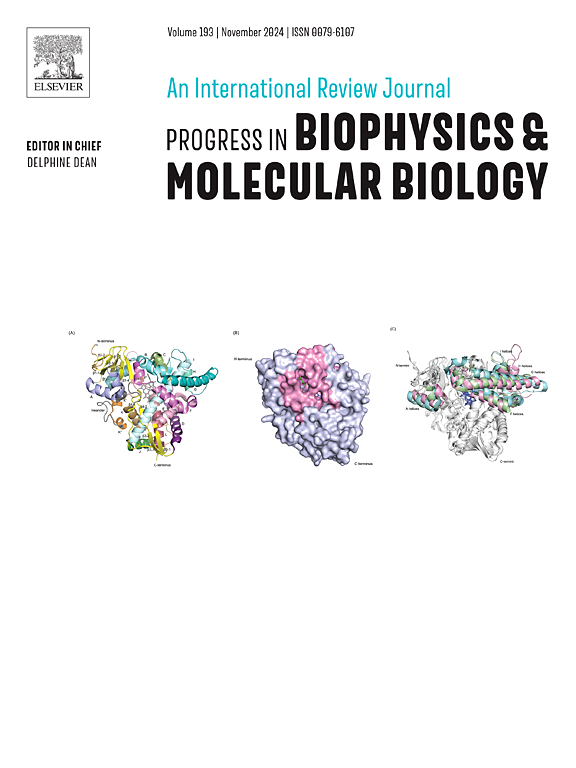From bench to Bone: Clinical promise of exosome-enhanced scaffolds in orthopedic regeneration
IF 4.5
3区 生物学
Q2 BIOCHEMISTRY & MOLECULAR BIOLOGY
Progress in Biophysics & Molecular Biology
Pub Date : 2025-10-01
DOI:10.1016/j.pbiomolbio.2025.10.001
引用次数: 0
Abstract
Bone regeneration remains one of the greatest challenges in orthopedic medicine, particularly in cases of complex fractures, nonhealing bones, or large bone defects. Traditional treatments, such as autologous grafts, allogeneic grafts, synthetic materials, or drug therapies, often face limitations, including donor-site pain, immune rejection, and limited ability to stimulate true bone healing. A promising new approach involves the use of exosome-enhanced scaffolds, which combine the structural support of biomaterial scaffolds with the potent regenerative effects of exosomes. Exosomes are nanosized vesicles secreted by cells such as mesenchymal stem cells, osteoblasts, and macrophages. They carry proteins, lipids, and regulatory RNAs that play crucial roles in coordinating bone formation, angiogenesis, and immune modulation. When incorporated into scaffolds, exosomes promote osteogenesis, stimulate vascularization, and facilitate tissue remodeling, thereby creating an optimal microenvironment for bone repair. Preclinical studies have demonstrated accelerated healing, enhanced bone strength, and improved overall bone quality, while early clinical trials indicate that these therapies are both safe and effective. Current research efforts focus on optimizing exosome isolation, understanding their interactions with scaffolds, and developing controlled delivery systems. This strategy holds great promise for transforming orthopedic care by providing patient-specific, biologically active treatments for even the most challenging bone defects.
从工作台到骨骼:外泌体增强支架在骨科再生中的临床应用前景
骨再生仍然是骨科医学中最大的挑战之一,特别是在复杂骨折,未愈合骨或大骨缺损的情况下。传统的治疗方法,如自体移植物、异体移植物、合成材料或药物治疗,往往面临局限性,包括供体部位疼痛、免疫排斥和刺激真正骨愈合的能力有限。使用外泌体增强支架是一种很有前途的新方法,它将生物材料支架的结构支持与外泌体的强大再生效应结合起来。外泌体是由间充质干细胞、成骨细胞和巨噬细胞等细胞分泌的纳米级囊泡。它们携带蛋白质、脂质和调控rna,在协调骨形成、血管生成和免疫调节中起着至关重要的作用。外泌体加入支架后,可促进成骨,刺激血管形成,促进组织重塑,从而为骨修复创造最佳微环境。临床前研究已经证明加速愈合,增强骨强度,改善整体骨质量,而早期临床试验表明这些疗法既安全又有效。目前的研究重点是优化外泌体的分离,了解它们与支架的相互作用,以及开发受控的递送系统。这种策略通过提供患者特异性的、生物活性的治疗方法,即使是最具挑战性的骨缺陷,也有望改变骨科护理。
本文章由计算机程序翻译,如有差异,请以英文原文为准。
求助全文
约1分钟内获得全文
求助全文
来源期刊

Progress in Biophysics & Molecular Biology
生物-生化与分子生物学
CiteScore
8.60
自引率
7.90%
发文量
85
审稿时长
85 days
期刊介绍:
Progress in Biophysics & Molecular Biology is an international review journal and covers the ground between the physical and biological sciences since its launch in 1950. It indicates to the physicist the great variety of unsolved problems awaiting attention in biology and medicine. The biologist and biochemist will find that this journal presents new and stimulating ideas and novel approaches to studying and influencing structural and functional properties of the living organism. This journal will be of particular interest to biophysicists, biologists, biochemists, cell physiologists, systems biologists, and molecular biologists.
 求助内容:
求助内容: 应助结果提醒方式:
应助结果提醒方式:


